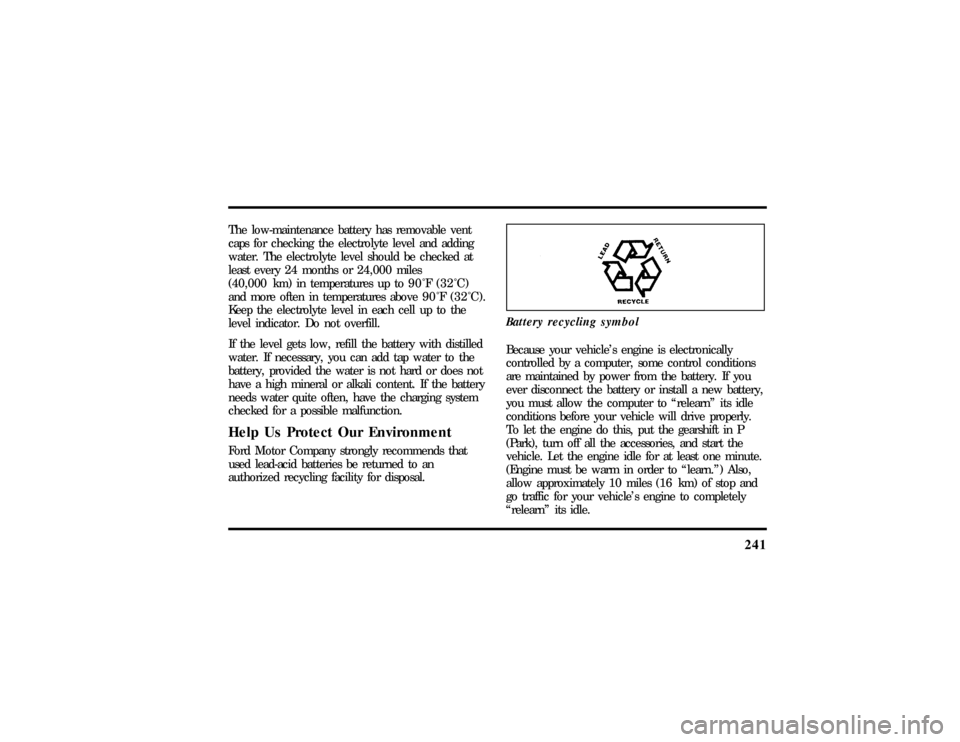1997 LINCOLN CONTINENTAL check engine
[x] Cancel search: check enginePage 240 of 321

239
Checking the Automatic Transaxle
FluidWith the vehicle on a level surface and the brake
fully applied, start the engine and move the gear
shift selector through all of the gears allowing
sufficient time for each position to engage. Securely
latch the gear shift selector in the P (Park) position.
Fully set the parking brake and leave the engine
running.
Wipe off the dipstick cap and pull the dipstick out.
Wipe the indicator end clean. Put the dipstick back
into the filler tube and make sure it is fully seated.
Pull the dipstick out and read the fluid level.
NOTE:Your vehicle should not be driven until
some fluid has been added if the fluid level is
below the bottom dimple on the dipstick and the
outside temperature is above50ÊF(10ÊC). Addonly
enough fluid to bring the level above the bottom
hole.If the vehicle has not been driven and the fluid
level is above the bottom dimple on the dipstick, do
not add fluid. Recheck the fluid level after your
vehicle has reached normal operating temperature.
Normal operating temperature is reached after
driving approximately 20 miles (30 km). The fluid
level should be within the crosshatched area on the
dipstick.
NOTE:If the vehicle has been operated for an
extended period at high speeds, driven in city traffic
during hot weather, or has been pulling a trailer,
the vehicle should be turned off for about 30
minutes to allow the fluid to cool before checking.
File:11fnmcc.ex
Update:Fri Sep 6 08:51:16 1996
Page 242 of 321

241
The low-maintenance battery has removable vent
caps for checking the electrolyte level and adding
water. The electrolyte level should be checked at
least every 24 months or 24,000 miles
(40,000 km) in temperatures up to90ÊF(32ÊC)
and more often in temperatures above90ÊF(32ÊC).
Keep the electrolyte level in each cell up to the
level indicator. Do not overfill.
If the level gets low, refill the battery with distilled
water. If necessary, you can add tap water to the
battery, provided the water is not hard or does not
have a high mineral or alkali content. If the battery
needs water quite often, have the charging system
checked for a possible malfunction.Help Us Protect Our EnvironmentFord Motor Company strongly recommends that
used lead-acid batteries be returned to an
authorized recycling facility for disposal.Battery recycling symbol
Because your vehicle's engine is electronically
controlled by a computer, some control conditions
are maintained by power from the battery. If you
ever disconnect the battery or install a new battery,
you must allow the computer to ªrelearnº its idle
conditions before your vehicle will drive properly.
To let the engine do this, put the gearshift in P
(Park), turn off all the accessories, and start the
vehicle. Let the engine idle for at least one minute.
(Engine must be warm in order to ªlearn.º) Also,
allow approximately 10 miles (16 km) of stop and
go traffic for your vehicle's engine to completely
ªrelearnº its idle.
File:11fnmcc.ex
Update:Fri Sep 6 08:51:16 1996
Page 243 of 321

242If you do not let the engine relearn its idle, the idle
quality of your vehicle may be adversely affected
until the idle is relearned. Your vehicle will
eventually relearn its idle while you drive it, but it
takes much longer than if you use the previous
procedure.Passenger Compartment Air FilterUsing a screwdriver,
1. Remove the two screws retaining the passenger
side half of the cowl vent screen.
2. From inside the vehicle, pull the hood release.
3. Open the hood, then pull the hood pad away
from the cowl vent screen.
4. Remove the cowl vent screen, then the filter.
Reverse procedure to install. The filter must be
properly positioned in the housing for proper
installation.
Wiper BladesCheck the windshield wiper blades at least twice a
year. Also check them whenever they seem less
effective than usual. Substances such as tree sap
and some hot wax treatments used by commercial
car washes reduce the effectiveness of wiper blades.
If the blades do not wipe properly, clean both the
windshield and the wiper blades. Use undiluted
windshield washer solution or a mild detergent.
Rinse thoroughly with clear water. Do not use fuel,
kerosene, paint thinner, or other solvents to clean
your wiper blades. These will damage your blades.
To make reaching the wiper blades easy, simply
turn the ignition to the ACC position and turn your
wipers on. Wait for them to reach a vertical
position and turn the ignition to the OFF position.
Do not move the wipers manually. Manually
moving the wipers across the windshield may
damage them.
File:11fnmcc.ex
Update:Fri Sep 6 08:51:16 1996
Page 261 of 321

260Do not make any unauthorized changes to your
vehicle or engine. Changes that cause more
unburned fuel to reach the exhaust system can
increase the temperature of the engine or exhaust
system.
By law, anyone who manufactures, repairs, services,
sells, leases, trades vehicles, or supervises a fleet of
vehicles is not permitted to intentionally remove an
emission control device or prevent it from working.
In some of the United States and in Canada,
vehicle owners may be liable if their emission
control device is removed or is prevented from
working.
Do not drive your vehicle if it does not operate
properly. See your dealer if the engine runs on for
more than five seconds after you shut it off or if it
misfires, surges, stalls, or backfires.Information about your vehicle's emission control
system is on the Vehicle Emission Control
Information decal located on or near the engine.
This decal identifies engine displacement and gives
some tune-up specifications.
How to Prepare Your Vehicle for
Inspection/Maintenance (I/M) TestingIn some localities it may become a legal
requirement to pass an Inspection/Maintenance
(I/M) test of the On-Board Diagnostic (OBD) II
system. If the vehicle's powertrain system or its
battery has just been serviced, the OBD II system is
reset to a not ready for I/M testing condition. To
prepare for I/M testing, the law specifies that
additional mixed city and highway driving is
required to complete the check of the OBD II
system.
File:11fnmcc.ex
Update:Fri Sep 6 08:51:16 1996
Page 262 of 321

261
The driving modes required to reach the ready
condition consist of a minimum of 30 minutes of
city and highway driving as described below:q
At least twenty minutes driving in stop and go,
city type traffic with at least four idle periods.
q
At least ten minutes of driving on an
expressway or highway.
Before completing the above driving modes, the
engine must be warmed up and at operating
temperature. Once started, the vehicle must not be
turned off during these driving modes.
Lights and Bulb ReplacementIt is a good idea to check the operation of the
following lights frequently:q
headlamps
q
high-mount brakelamp
q
tail lamps
q
brakelamps
q
hazard flasher
q
turn signals
q
side markers
q
license plate lamps
The alignment of your headlamps should be
checked if:
q
oncoming motorists frequently signal you to turn
off your vehicle's high beams when you do not
have the high beams on
q
the headlamps do not seem to give you enough
light to see clearly at night
q
the headlamp beams are pointed substantially
away from a position slightly down and to the
right
File:11fnmcc.ex
Update:Fri Sep 6 08:51:16 1996
Page 308 of 321

310Clutch
fluid reservoir............ 229
specifications............ 273
Cold engine starting.......... 166
Combination lap and shoulder belts . 135, 137
Compact disc player (see Electronic sound
system)............... 35
Compact disc radio (see Electronic
sound system)............ 27
Console, description.......... 113
Controls, mirrors............ 92
Convenience kit in cargo area...... 206
Coolant (see Engine coolant)....... 231
checking and adding......... 231
preparing for storage......... 275
refill capacities............ 272
specifications............ 273
temperature gauge.......... 17
warnings.............. 231
Cooling fan.............. 221
Crankcase emission filter........ 271Customer Assistance Centre,
Ford of Canada............ 284
D
Daytime running light system...... 56
Defects, reporting............ 277
Dipstick................ 227
automatic transaxle fluid....238, 239
engine oil.............. 227
power steering fluid......... 237
Disabled vehicle (see Towing)...... 217
Dispute Settlement Board........ 280
Doors................. 103
lubricant specifications........ 273
Driving under special conditions
heavy load............. 183
towing a trailer........... 185
E
Electrical system, fuses......192, 203
Electronic sound system
antenna............... 31
tuning the radio........... 27
File:fnixc.ex
Update:Tue Sep 17 08:28:54 1996
Page 309 of 321

311
Electronic sound system (continued)
warranty and service information.... 44
Electronic stereo cassette radio
(see Electronic sound system)..... 27
Electronic stereo radio (see Electronic
sound system)............ 27
Emergencies, roadside
fuel................ 255
jump-starting............ 211
towing............... 217
Emergency brake (parking brake)..... 172
Emission control system......... 258
catalytic converter.......... 258
emissions warranty.........4,258
Engine
does not start.........167, 191
fuel injected engine, starting . . . 165, 166
fuel pump shut-off switch....... 191
preparing to start.......... 165
refill capacities............ 272
service points............ 224
starting............... 166starting after a collision........ 191
storing your vehicle......274, 275
Engine block heater........... 168
Engine coolant............. 231
checking and adding......... 231
disposal............220, 240
preparing for storage......... 275
proper solution........220, 240
recovery reservoir.......224, 231
refill capacities............ 272
specifications............ 273
temperature gauge.......... 17
Engine coolant temperature gauge..... 17
description............. 17
mechanical............. 17
Engine coolant temperature
guage:electronic........... 17
Engine fan............... 221
Engine knocking............ 253
Engine oil............... 226
ªbreak-inº oils............. 5
changing oil and oil filter....227, 228
File:fnixc.ex
Update:Tue Sep 17 08:28:54 1996
Page 310 of 321

312
checking and adding......... 227
check oil warning light........ 12
dipstick............... 227
disposal............220, 240
engine oil pressure warning light.... 12
filter, specifications.......... 271
low oil warning light......... 12
refill capacities............ 272
specifications.........226, 273
synthetic oil............. 226
viscosity.............. 226
F
Fan.................. 221
engine fan, avoiding injury...... 221
Flashers, hazard............ 68
Flashing the lights........... 65
Flat tire................ 205
Fluid refill capacities.......... 272
Ford Dispute Settlement Board...... 280
Ford Motor Company of Canada..... 284
Ford of Canada CustomerAssistance Centre........... 284
Foreign registration........... 286
French owner guides, how to obtain.... 3
Fuel................. 251
calculating fuel economy....... 256
capacity............... 272
choosing the right fuel........ 253
comparisons with EPA fuel
economy estimates......... 257
filling your vehicle with fuel...... 251
filter, specifications.......... 271
fuel filler door release lever...... 251
fuel gauge.............. 18
octane rating............ 253
quality............... 253
running out of fuel.......... 256
safety information relating to
automotive fuels.......... 255
storing your vehicle......... 275
treating emergencies......... 255
Fuel cap................ 251
removing.............. 251
File:fnixc.ex
Update:Tue Sep 17 08:28:54 1996